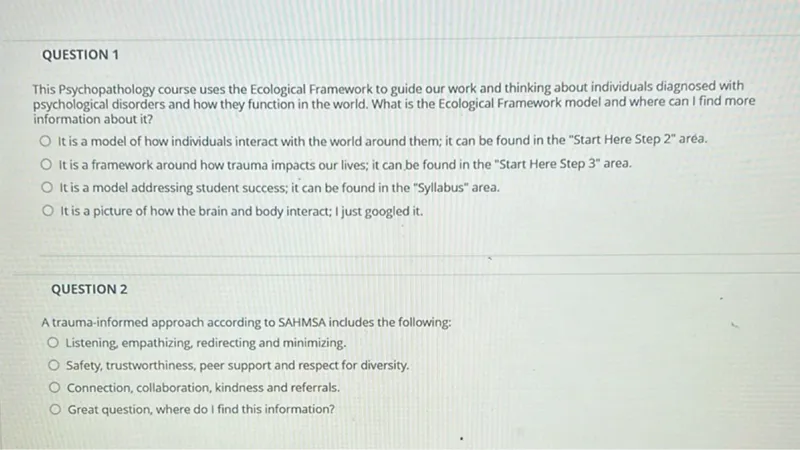Questions: QUESTION 1 This Psychopathology course uses the Ecological Framework to guide our work and thinking about individuals diagnosed with psychological disorders and how they function in the world. What is the Ecological Framework model and where can I find more information about it? It is a model of how individuals interact with the world around them; it can be found in the "Start Here Step 2" area. It is a framework around how trauma impacts our lives; it can be found in the "Start Here Step 3" area. It is a model addressing student success; it can be found in the "Syllabus" area. It is a picture of how the brain and body interact; I just googled it. QUESTION 2 A trauma-informed approach according to SAHMSA includes the following: Listening, empathizing, redirecting and minimizing. Safety, trustworthiness, peer support and respect for diversity. Connection, collaboration, kindness and referrals. Great question, where do I find this information?

Transcript text: QUESTION 1
This Psychopathology course uses the Ecological Framework to guide our work and thinking about individuals diagnosed with psychological disorders and how they function in the world. What is the Ecological Framework model and where can I find more information about it?
It is a model of how individuals interact with the world around them; it can be found in the "Start Here Step 2" area.
It is a framework around how trauma impacts our lives; it can be found in the "Start Here Step 3" area.
It is a model addressing student success; it can be found in the "Syllabus" area.
It is a picture of how the brain and body interact; I just googled it.
QUESTION 2
A trauma-informed approach according to SAHMSA includes the following:
Listening, empathizing, redirecting and minimizing.
Safety, trustworthiness, peer support and respect for diversity.
Connection, collaboration, kindness and referrals.
Great question, where do I find this information?





